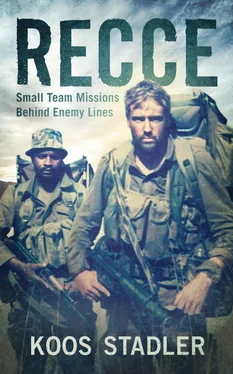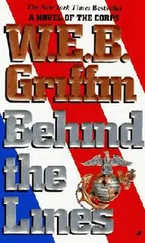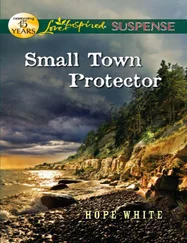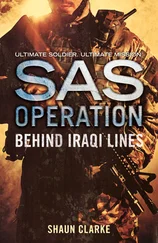My relationship with Sarel would grow steadily over the years to come, as he would always conduct a “last supper” – a communion held with only the team and the Tac HQ commander – prior to a Small Team deployment. He became my spiritual mentor.
Our mission at Nkongo was to dominate the area by sheer aggression and try to regain full control. It soon dawned on me that we would patrol the bush in teams of twelve to sixteen, like regular infantry. There would be little of the anti-tracking, deception techniques, stealthy movement and other tactics we had developed so meticulously during my years at 31 Battalion.
Our stick sergeant, an Angolan Portuguese, was a master- snorer because he suffered from a minor medical condition. At night his snores used to cut through the cold still air and send shivers down my spine. As a standard arrangement each night the sentry had to take position next to him and wake him every time he started snoring. The poor bugger didn’t sleep at all, as he started snoring the moment he fell asleep. We eventually requested that he be evacuated, as the situation started affecting the whole team.
Team leader Coen and I agreed that we would try some techniques to deceive the enemy, or at least not let them know our position. We started by avoiding the kraals and staying away from pathways. We moved frequently, and spent as little time as possible in static positions. Then we would close in on one of the suspect kraals, observing and searching for signs of enemy presence. I would often choose one of the soldiers to go on a close recce of the kraals and pathways, but soon realised that the men were extremely reluctant to do this. The idea of two guys alone in the bush was not their cup of tea.
Eventually we split the patrol in two; while the bigger group would guard the rucksacks in a temporary base (TB), the other ambushed the pathways leading to the kraals. I was lying in one of these ambushes one afternoon when the PKM [10] The PKM 7.62-mm general-purpose machine gun, developed in the Soviet Union in 1961, is still in wide use today.
gunner started spraying bullets all over the treetops. A small group of SWAPO cadres had strolled down the trail – straight into one end of our six-man ambush. Unfortunately, the machine-gunner was in Sunday-afternoon mode, and only realised there was trouble when he and the SWAPO point man came face to face. Frightened out of his wits, he started shooting with the PKM still on its bipod, pointing upwards. The cadres did an about-turn and seemed to disappear into the thicket almost casually.
Two nights later we approached the same kraal complex for a close checkout and to replenish our water supplies at one of the wells. We placed listening posts at two of the kraals while the rest formed an all-round defence at the well. I was still busy filling my water bottles when all hell broke loose. Apparently a SWAPO patrol had had the same idea as us, and was approaching the well from the opposite direction when they bumped into one of the listening posts. Coen and I simultaneously started running towards the contact, but I stepped in a hole and sprained my ankle. One of the cadres was killed, while the rest disappeared into the night.
The following morning we found the tracks of a large group that had moved south past the kraal, and had obviously sent out the small patrol to replenish water. A follow-up was immediately organised, but I had to be evacuated back to Nkongo base, as my foot was swollen thick and I could not put any weight on it.
Back at the base I was treated with much suspicion and had to endure a fair bit of abuse. My swollen ankle meant I was immobile for two weeks, but it was summarily concluded that I had concocted a reason to return to base and avoid being deployed. After a while, I had had enough of life at the base, and I was preparing to rejoin the team in the bush, regardless of my injury, when I was informed that I was to fly out to Ondangwa to join 51 Commando at Fort Rev. This next step in my relatively short Special Forces career had also been planned without any input from my side.
4
51 Reconnaissance Commando
“A man should totally be where he is.”
– Uncle Albertus in Dana Snyman,
On the Back Roads
THE SPECIAL FORCES command structure had called on newly qualified, single operator-officers to serve at Ondangwa, as 51 Commando was running short of leader group. The unit specialised in pseudo-guerrilla operations and most of its operators were ex-SWAPO cadres who had been captured and “turned” to work for the South African Defence Force. Although I was dying to join Small Teams, I did not have a say in the matter. The concept of pseudo-guerrilla operations was foreign to me, but I was ready to learn and explore the opportunities 51 Commando offered.
The successes of the Selous Scouts in then Rhodesia were well known in the Recces , and a number of its operators were now serving with us. When I arrived at Ondangwa, Staff Sergeant Jim Lafferty, a highly experienced operator from the Scouts, served with 51 Commando. I was fortunate to learn from a soldier of his calibre. Soon Jim would share his experiences with me and lead me into the intricacies of pseudo-operations.
In 1984 PW Botha became state president of South Africa. The national effort to counter the so-called total onslaught against South Africa, a perceived all-encompassing threat posed by communist-inspired forces both inside and outside the country’s borders, was steadily gaining ground. PW Botha was of course a strong exponent of the theory of the total onslaught, and established widespread countermeasures – of which the military effort formed but one – to combat the threat. Religion was used to instil a sense of patriotism among soldiers, who were told that South Africa was the last bastion of Christianity in southern Africa, since many of its neighbours were ruled by communist regimes after decolonisation. Soviet Russia, Cuba and East Germany also supported these governments and trained the guerrilla forces that were infiltrating both South West Africa and South Africa. By 1984 at least 6 000 insurgents were being trained and armed by the Soviet Union and Warsaw Pact member states in countries like Tanzania and Ethiopia. No fewer than 30 000 Cuban troops were positioned in Angola, though at this time still acting in a training and advisory role.
During February 1984 an agreement was reached at a high-level meeting of South African, Angolan and American observers in Lusaka. One of the provisions of the Lusaka Accord was the Mulungushi Minute, which determined, among other things, that the MPLA government would act to restrain SWAPO cadres from infiltrating South West Africa. The Mulungushi Minute also provided for the establishment of a Joint Monitoring Commission (JMC) to oversee the withdrawal of South African forces from Cunene province and ensure that SWAPO did not reoccupy territory vacated by the SADF. However, the JMC was slow to materialise, and it soon became clear that the Angolans could not afford to go through with a process that would help to install a non-SWAPO government in South West Africa, especially given their own precarious position vis-à-vis Jonas Savimbi’s UNITA.
So cadres from the People’s Liberation Army of Namibia (or PLAN, the military wing of SWAPO) were still crossing the border into South West Africa, and it was 51 Commando’s exclusive job to infiltrate the guerrilla structures and become part of the detachments penetrating Ovamboland.
Fort Rev, a completely enclosed and highly secretive camp, was conveniently situated next to the runway within the larger Ondangwa Air Force Base area. It served as the commando’s headquarters and accommodation. Some of the ex-SWAPO insurgents were absolute masters in the bush: they knew the area intimately, spoke the language and blended in as easily as any SWAPO cadre. Once a cadre had been “turned”, he would be given a whole new identity and deployed to areas of Ovamboland where he was not known.
Читать дальше












